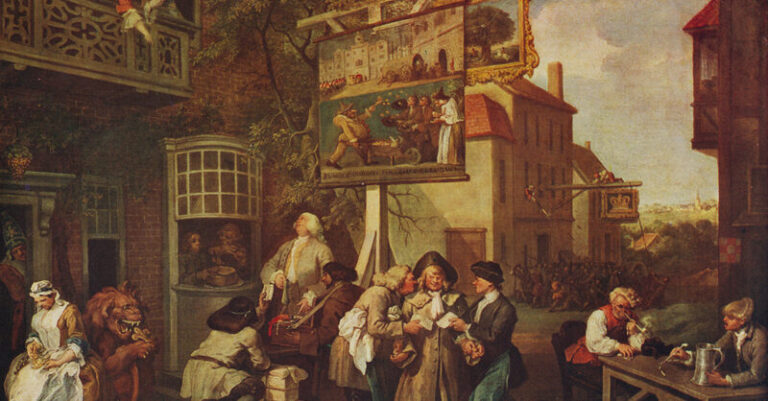Alongside so many other certainties of world politics that appear now to be in question, Britain may soon see the collapse of its centuries-old, two-party system. Now, then, is a good moment to reappraise how the long-admired British political system, with its peculiar mix of constitutional monarchy and representative democracy, arose. Held up as an example to others – the “mother of parliaments” – England has long been admired for its revolution-proof political stability. But how did this come to be?
That is the subject explored in The Rage of Party, a fine book by the young historian and highly influential social media personality, George Owers, who locates the answer in the development of two-party competition – between the so-called Whigs and Tories – in England between 1689 and 1714. As the author himself cheerfully acknowledges, experts in the field have already made this argument; Owers’ own depends on a synthesis of existing scholarly work, leavened by original pamphlets, newspapers and published letters. While offering the general reader a detailed and lively narrative of British political history in that period – one that is not necessarily very familiar to the public – Owers successfully shows how the bitter contest between Whigs and Tories, the first properly organised English political parties, and among the oldest in the world, laid the basis for a system that has worked ever since.
He begins by tracing their development through the late 1600s, as a response to the problems created by the shattering of the Church of England during the civil wars earlier that century. This created a huge new problem in the form of divergent Protestant denominations, including Presbyterians, Congregationalists, Baptists and Quakers, whom orthodox Anglicans were unwilling to tolerate and unable to eradicate. The Tories called for a powerful Church with minimal or no rights for dissenters, while the Whigs were much more inclined to accommodate the latter as members of English society.
These attitudes also produced differing approaches to foreign policy. Whigs saw English Protestantism as a branch of the kind found across Europe, and called for a crusade against Roman Catholic monarchies, in alliance with continental Protestant states. Tories, on the other hand, viewed the Church of England as a unique institution, which had little in common with other Protestant denominations, whether here or abroad, and wanted an isolationist foreign policy. As with most ideological terms of the period, both party names were originally insults intended by their opponents to misrepresent them. The “real” Tories were Roman Catholic Irish rebels while the “real” Whigs were Scottish Presbyterian rebels.
In the 1680s, Owers recounts, a new king, James II, overthrew the by then almost sacrosanct rules of English politics by trying to impose Roman Catholicism on his kingdoms (which included England, Scotland and Ireland), and in doing so alienated both Whigs and Tories. They were rescued by the Dutch national army, which invaded England in 1688 under their leader, William of Orange, husband of James’s Protestant daughter Mary. In this so-called Glorious Revolution, James was driven out of power, and William and Mary became rulers in his place.
Mary’s sister Anne replaced them, and during the period of her reign – a pivotal period in the story of Whigs and Tories – the book slows to provide a denser narrative. Two thirds of the book, in fact, are devoted to the politics of the reign of Queen Anne, under whom Britain was created as the union of England and Scotland. The Tories took up the cause of the landowners who were being taxed to finance wars against Catholic France, where James II had taken refuge. War was, in a sense, necessary, because France remained committed to the Catholic exiled former monarch’s restoration. Land taxes hit country squires especially hard, and urban financiers profited by lending the government money which the tax repaid with interest. Party animosity was also sharpened by the institution of general elections at least every three years, which made campaigning almost unceasing.
Queen Anne’s reign, Owers shows, entailed an intensification of this pattern, driven by the renewal of war with France and the exiled Catholic royal family. Land was taxed, financiers made even bigger profits, and the bitterness of the Anglican clergy against dissenters increased. The union had also grafted Scottish politicians onto the English system. Partisan hostility thus reached fever pitch. As party leaders ran into the determination of the queen to appoint ideologically mixed ministries while avoiding having policy dictated to her by her ministers, party rivalry increased.
But Anne fought a losing battle. Initially, the superior political skills of the Whigs made them dominant in the government, but the Tories won increasing popularity by championing an end to the war and the taxation associated with it, as well as the defence of the national Church. They eventually took control of the monarchy, and drove the Whigs out of office – only to hit disaster when the queen died. The only credible Protestant successor was the elector of Hanover, George, one of the Continental allies whom the Tories had abandoned by making peace. He did what Anne never would: he instituted a one-party government of Whigs. This lasted for much of the 18th century.
Owers tells this story, month by month, in all its complexity, never losing the bigger picture while making the details riveting. The leading characters are vividly delineated in their strengths and weaknesses. Underpinning it all, is his argument that the British two-party system, which made our democracy function, was born amid all this turmoil.
To an extent, he is correct. But a longer view would suggest that the instability of 17th-century England was created by three enduring problems: first, the relationships between England, Scotland and Ireland, three different countries awkwardly brought under common rule; similarly, the relationship between the new Church of England and those unhappy with the form of religion it provided, and lastly, a disagreement about the ultimate location of power in the state. By the 1680s, it looked as if these structural problems would be resolved by a stronger and more independent monarchy, with more hard-line national Churches. William of Orange’s settlement provided an alternative solution: ultimate power was vested in parliament, with England becoming dominant in a new British superstate, and the Church strongly influencing power but with toleration of worship outside it.
The bipartisanship described by Owers feed off the tensions of this new order. One vital ingredient is still missing, however: the idea that it was healthy for a state to be run by a single-party government, while the party currently out of power was still represented in parliament, functioning as a critic of the government of the day and offering an alternative to it. That was created by King George’s long-term installation of the Whigs in power. The Tories maintained substantial minorities in parliament. Their constant presence as critics of the Whig government, coupled with the prolonged security of that government in office, embedded forever in British politics the idea that a healthy state benefited from the presence of a “loyal opposition”. That was the final establishment of our enduring and stable system.
This suggests lessons for the present, when there is much talk of regime change. The first is that the system concerned evolved gradually and organically, as a result of historical accidents, rather than being constructed as a whole by founding parents. It may, therefore, not easily function as a model for anybody else. Other nations will need their own experiences to make a democratic system work for them. Moreover, contingent political developments here, in the future, could just as easily, or by accident, cause it to unravel.
The Rage of Party: How Whig Versus Tory Made Modern Britain
George Owers
Constable, 576pp, £30
Purchasing a book may earn the NS a commission from Bookshop.org, who support independent bookshops
Content from our partners



